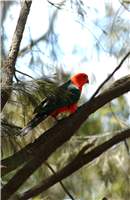Family
Psittacidae
Genus
Alisterus
Species
scapularis
Threats/Control Methods - Regional
Forestry activities and land clearing impact on the number of tree hollows available for nesting. The 2003 bushfires also heavily impacted upon the King-Parrot's forest nesting sites.
Threats/Control Methods - Local
Common Mynas (Acridotheres tristis ) or Starlings (Sturnus vulgaris ) aggressively defend the declining nesting hollows within the suburbs.
Local/Urban Actions
Nest boxes provide a good artificial alternative to tree hollows. King Parrots prefer a vertical nest box at least 10m up, with a 9cm entrance diameter and a 24cm inside diameter. Ensure the nest box is visible and pest birds such as Common Mynas (Acridotheres tristis ) or Starlings (Sturnus vulgaris ) are not using it.
Common Names
Australian King-Parrot, Southern King Parrot, King Lory
Distinguishing Features
This species is the largest of all the brightly coloured local parrots at 42cm and is distinctive by the entirely red head of male parrots and the green head of females. Both sexes have a red belly and a green back, with green wings and a long green tail.
Survey Techniques
Call and visual identification
Species Call
In flight, a sharp 'charrak' or rapid 'charak-chrak-chrak'. Perched males: 'chreip, peeip, peip'
Similar Species
The adult Crimson Rosella (Platycercus elegans ) is similar to the male King-parrot, however it has distictive blue colourings over its body.
Distribution
King-Parrots are found along the east coast and ranges of Australia, ranging from Cooktown in Queensland through to Port Campbell in Victoria.
Country of Origin
Australia
Conservation (Pet/Pest) Status - Regional
It is most common in the ranges to the west of Canberra, having dramatically increased its population since 1981 (COG).
Conservation (Pet/Pest) Status - National
Secure, not listed under the EPBC Act 1999. The Australian King-Parrot is increasing in abundance across the country, especially in green, leafy suburbs.
LSCCES Population
The highest detection frequencies were found on the ANU campus and CSIRO with lower values in the ANBG, Black Mountain, Civic West and Turner.
Associated vegetation community
King-Parrots are usually found in the rainforest or wet eucalypt forest. In the Canberra region they have adapted well to the adjoining forests for roosting and suburban gardens for daily feeding.
Limiting Resources
Due to the range and variety of garden plants bearing edible fruits and seeds, the Australian King-Parrot survives well during winter in this region. Substantial tree hollows are needed for nesting, as the species prefers an entrance of up to 10m in the tree, with eggs close to the ground.
Breeding
The breeding season extends from September and peaks in January. Large white eggs are laid in the hollows of tree trunks on decaying wood. A clutch size is usually 3-5, with an incubation period of 20 days followed by 35 days in the nest. The female is the sole carer of the eggs and young, while the male collects food and feeds his partner and young.
Behaviour
Large numbers can be seen flying from their communal roosts to their daily feeding area just after sunrise and in the evening.
Functional Group
Food Species
The King-Parrots feeds on berries and other fruits, nuts, leaf buds, seeds, nectar and blossoms.
Predators
Due to the large size of this parrot, it is less likely to be attacked by European Red Foxes (Vulpes vulpes), Dogs (Canis familiaris) or Cats (Felis catus). However, it is still vulnerable.
Interesting Fact
When viewed under ultraviolet light, some feathers on the wings of the King-Parrot have a yellow glow.
References - (reader suitability of references, P=Primary teachers, S=Secondary students, T=Tertiary students and researchers)
Books:Delgale, J. 1997. Attracting Birds to your Garden in Australia. New Holland Publishing. NSW. P, S, T
Morcomber, M. 2000. Field guide to Australian Birds. Steve Parish Publishing, Archerfield. P, S, T
Schodde, R. and Tideman, S. (eds) 1990. Reader's Digest Complete Book of Australian Birds (2nd Edition). Reader's Digest Services Pty Ltd. Sydney. P, S, T
Veerman, P. 2003. Canberra Birds: A report on the first 21 years of the garden bird survey. Philip Veerman and Canberra Ornithologists Group. Canberra. S, T
Internet: Birds in Backyards 2006. [online]. Available at:http://www.birdsinbackyards.net P, S, T
Canberra Ornithological Group (COG). 2004. Birds of Canberra Gardens. COG and the ACT Department of Urban Services. [online]. Available at:http://garden.canberrabirds.org.au/ P, S, T
Online Publications: Nix, H. and Cunningham, R. 2006. Birds of the Lower Sullivans Creek Catchment, Canberra ACT. Prepared for the Life in the Suburbs project using data from the Lower Sullivans Creek Catchment Ecological Survey (LSCCES). Australian National University. Canberra. [online]. Available at: http://www.lifeinthesuburbs.com.au/category.php?id=65
Olsen, P. et al. 2005. The State of Australia's Birds 2006: Invasive Species. Supplement to Wingspan 16:4. Birds Australia. [online]. Available at: http://www.birdsaustralia.com.au/soab/SOAB2006.pdf S, T

 Top
Top Top
Top